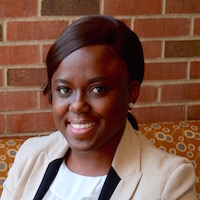More treatment options needed for HIV-positive women with cervical dysplasia, study finds
September 18, 2017
Three researchers from the UNC Gillings School of Global Public Health are co-authors of an article that compares two treatments for cervical dysplasia, a precancerous condition in which abnormal cell growth occurs on the lining of the cervix.
The full article, titled “A randomized clinical trial comparing cervical dysplasia treatment with cryotherapy vs loop electrosurgical excision procedure in HIV-seropositive women from Johannesburg, South Africa,” was published in the August issue of the American Journal of Obstetrics & Gynecology.

Busola Sanusi

Dr. Michael Hudgens

Dr. Jennifer Smith
Co-authors from the Gillings School include Jennifer S. Smith, PhD, professor of epidemiology, Michael Hudgens, PhD, professor of biostatistics, and Busola Sanusi, MA, doctoral candidate in the biostatistics department. Smith also is a member of the UNC Lineberger Comprehensive Cancer Center.
These researchers worked with colleagues from four institutions in South Africa to conduct a study that compared treatment of cervical dysplasia using cryotherapy (which destroys abnormal tissue by freezing it) with treatment using the loop electrosurgical excision procedure (or “LEEP,” which uses a fine wire loop with a low-voltage electrical current to cut away abnormal tissue).
The study population was specifically HIV-positive women in Johannesburg, South Africa. The researchers worked with this population because, while death from cervical cancer is a major public health concern for all women, HIV-positive women have an increased risk of developing high-grade cervical pre-cancer. Additionally, cervical cancer is the leading cause of cancer-related death among women in sub-Saharan Africa, where there is limited access to effective treatment procedures.
When the researchers compared the efficacy of cryotherapy and LEEP in a randomized controlled trial including 166 women, they found that both treatments were effective in reducing the presence of abnormal cervical cells by at least 70 percent at 12 months post-treatment. There was no statistically significant difference in the effectiveness of the treatments at that point, nor any serious adverse effects for either treatment.
The researchers did observe, however, that there were relatively high recurrence rates of abnormal cells at 12 months following both types of treatment — 27 percent for cryotherapy and 19 percent for LEEP. These recurrence rates were higher than those observed in previous studies conducted among women who were not all HIV-positive, indicating a need to explore altogether different protocols in order to optimally treat cervical dysplasia in women living with HIV.
“This study is the first to highlight the need to identify a different treatment method to better prevent invasive cervical cancer in HIV-positive women,” Sanusi said. “It is crucial that the procedures we eventually identify be both effective and affordable.”
Co-authors from South Africa include: Avril Swarts, MSc, Simon Levin, FRCOG, Pam Michelow, MD, Tanvier Omar, FCPATH (SA), and Cynthia Firnhaber, MD, from the University of Witwatersrand; Mark Faesen, FCOG, Bridgette Goeieman, MBBCh, Sibongile Ramotshela, PN, and Ntombiyenkosi Rakhombe, PN, from Right to Care; and Anna L. Williamson, PhD, from the University of Cape Town. Williamson also works with the National Health Laboratory Service, as do Michelow and Omar; Firnhaber also worked with Right to Care.
Gillings School of Global Public Health contact: David Pesci, director of communications, (919) 962-2600 or dpesci@unc.edu
